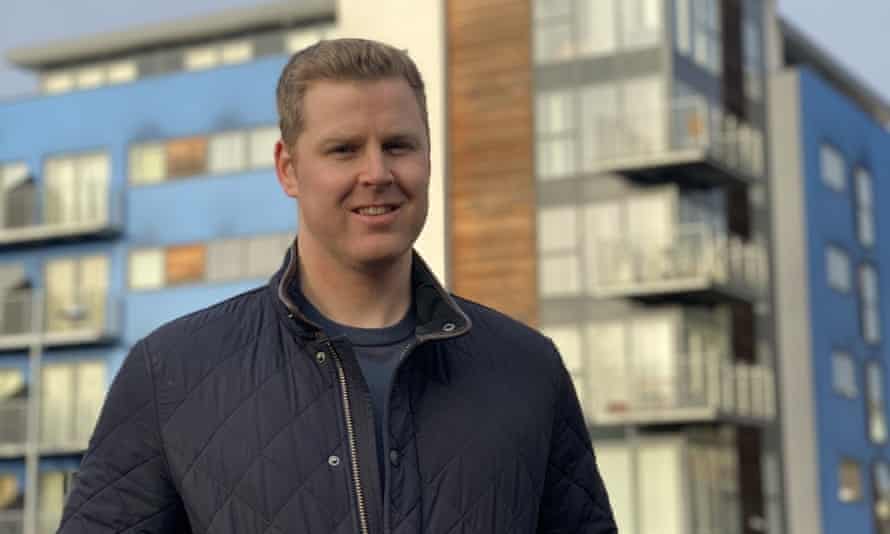‘It feels like a betrayal’: building safety funding falls short for many
Across the nation, leaseholders awaited Robert Jenrick’s resolution to the building safety disaster with hope. For these in buildings greater than 18 metres tall with flamable cladding but to be mounted, the information of £3.5bn in new grant funding was welcome. But for a whole lot of 1000’s of others in unsellable houses in lower-rise blocks with the identical cladding, there was disappointment on the provide of loans. And for individuals with different non-cladding fireplace safety issues, there was nothing.
Giles Grover purchased a ninth-floor flat within the City Gate advanced in central Manchester in 2012 for £147,000. Almost a decade on, he and his neighbours are dealing with a invoice of greater than £5m to make their houses protected, none of which might be coated by Wednesday’s new funds. Parts of the partitions have been clad in related aluminium composite materials (ACM) to that of Grenfell Tower, there have been timber balconies, and inner steelwork had not been correctly handled in opposition to fireplace. Other issues lurked behind the brickwork and render, the place boundaries in opposition to fireplace unfold have been lacking.
It was a cocktail of issues that collectively would value £11m to repair, however solely half has been coated up to now by the federal government’s funds to take away harmful cladding, and Wednesday’s announcement supplied no additional assist.
“We have applied to the ACM fund and we have been told £5.6m plus VAT would be covered as it stands,” he mentioned. “It means an average bill of £20,000 each. We still have that £20,000 debt and we are not being offered loans [to fix the non-cladding problems]. This is not a full solution. It only deals with part of the problem. They have extended the money for cladding but we know that what started as a cladding scandal has become a building safety scandal.”
He mentioned there had been no gross sales of flats within the building for virtually two years as a results of the issues. “No one can get a mortgage and flats are valued at zero,” he mentioned. “Now the insurers have told us the premium is going up and we don’t know by how much.”
The leaseholders have already spent round £150,000 on prices corresponding to waking watch, alarms and minor inner works. The landlord of the building has mentioned it doesn’t have duty, and the builder mentioned 18 months in the past that it could assess the scenario independently, however nothing conclusive has but come again.
Paul Afshar, 37, a expertise firm worker, lives along with his accomplice in a one-bedroom flat within the low-rise Ducketts condominium building in Tower Hamlets, east London, which is wrapped in timber cladding now deemed unsafe.
The building is just 4 storeys, so it doesn’t meet the 18-metre threshold. He and different residents expect payments of greater than £40,000 every to repair the issue. That is made worse by the truth that Afshar solely owns 25% of the flat, having bought it in 2008 as a part of a authorities shared possession scheme. The relaxation is owned by a registered social landlord. Nevertheless, he’s anticipated to pay 100% of the remediation prices.
The authorities’s announcement that folks in his place might take a long-term mortgage to pay for repairs was “no help whatsoever”, he mentioned, warning that it might exacerbate his issues and imply long-term debt and “more sleepless nights”.
“Last week the prime minister said no leaseholder should have to pay for the removal of cladding, so this feels like a betrayal,” he mentioned. “This long-term loan could haunt you as you go from property to property, and it is not clear it goes with you or stays with the property. We are talking about hundreds of thousands if not millions of people living in lower-rise flats who have the same problem today that they work up with yesterday.
“I have tried to sell the apartment twice in the last 12 months but both sales fell through. Mortgage lenders were unwilling to loan on buildings with cladding and without an external wall system survey.”
These EWS1 surveys have change into a main issue as there was a persistent scarcity of surveyors, which suggests Afshar’s block has not but been checked.

Zoe Bartley, 28, and her accomplice dwell in a six-storey block in Chelmsford, and first discovered there have been issues with the building after they determined to promote and requested their housing affiliation for an EWS1 type. “We’ve had inspections going on for the past 12 months and they have told us that there is high-pressure laminate cladding on parts of the building, insulation that was incorrectly fitted and missing fire breaks,” she mentioned.
The building is “technically under 18 metres”, she mentioned: for those who measure to its highest level it’s taller, nevertheless it doesn’t qualify for assist via the building safety fund, so her solely hope is the mortgage scheme.
They personal 30% of a one-bedroom flat on the primary flooring, however the phrases of their lease imply they’re liable for 100% of the prices of labor. “There’s a blank cheque sitting above our heads,” she mentioned. The couple have a child on the way in which, and her accomplice has two kids, so they’re eager for more room. “We need to see what the lenders do now and whether they are happy with the loans,” she mentioned. “I hope that banks will be reasonable because the thought of living here for longer than we had planned is depressing.”
She feels annoyed that leaseholders in buildings like hers will nonetheless be assembly the price of work. “£50 a month feels like a bit of a slap in the face to put right something that wasn’t our fault in the first place,” she says. “It’s affordable housing, so even £50 a month might make it unsellable.”

Scott Mason, 31, moved into his flat in Birmingham within the spring of 2017. He is a director of the residents’ administration firm, which found final yr that main work was wanted to make the block protected. As effectively as non-ACM cladding, there are flamable balconies, flammable insulation, lacking cavity boundaries behind brick dealing with, and issues with the inner compartmentation. It’s greater than 18 metres tall, so the administrators have utilized for £11.5m from the building safety fund to repair the exterior issues, and they’re ready to see how a lot they’ll get. “The fund has been increased but still only covers cladding and excludes other defects, so I won’t be particularly celebrating,” Mason mentioned. “We got bills before Christmas. Mine was £48,000. It will still be around £30,000 to cover non-cladding fire safety issues.”
Mason mentioned that with out assist to type out the opposite points, “you can only afford to remediate specific problems and you’ve still only got a half-safe building. It still won’t get you an EWS1 form as the fire engineer demands the other works are completed, so the flat is still unsellable and unsafe.”
He mentioned the principles across the fund have been nonetheless unclear. “There is a grey area: it’s not clear whether buildings are legally obliged to raise the shortfall for non-cladding works as a condition to qualify for the money for the cladding.”




